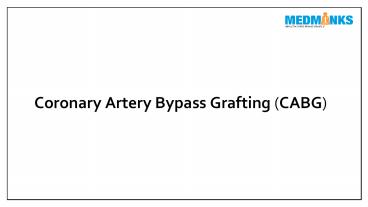Coronary Artery Bypass Grafting (CABG) - PowerPoint PPT Presentation
Title:
Coronary Artery Bypass Grafting (CABG)
Description:
Coronary Artery Bypass Graft (CABG) is the most commonly performed surgery. New routes around narrow and blocked arteries are created. It allows sufficient blood flow to deliver oxygen and nutrients to the heart muscles. It is advised for selected group of patients with significant blockages and narrowing of the heart arteries (coronary artery disease) – PowerPoint PPT presentation
Number of Views:195
Title: Coronary Artery Bypass Grafting (CABG)
1
Coronary Artery Bypass Grafting (CABG)
2
TABLE OF CONTENT
- What is CABG?
- How is CABG helpful?
- Benefits
- Complications after CABG
- Risks Associated
- How to prepare for the surgery?
- CABG Procedure
- Post-Operation
- CABG in India
- Cost of CABG in India
3
WHAT IS CABG?
- Coronary Artery Bypass Graft (CABG) is the most
commonly performed surgery. - New routes around narrow and blocked arteries are
created. - It allows sufficient blood flow to deliver oxygen
and nutrients to the heart muscles. - It is advised for selected group of patients with
significant blockages and narrowing of the heart
arteries (coronary artery disease)
4
HOW IS CABG HELPFUL?
- Coronary Artery Bypass Graft helps in the
following ways - CABG improves the oxygen supply and blood flow
to the heart. - CABG Surgery completely relives or reduces angina
symptoms in patients. - Also, it lowers the risk of heart attack or other
heart problems.
5
BENEFITS
- The benefits of the CABG are as follows
- Reduced risk of heart attack
- Active and healthy lifestyle
- Pumping ability of the heart is improved
- Reduced CHD symptoms
6
COMPLICATIONS AFTER CABG
- Complications increase with
- Diabetes
- Chronic lung disease
- Age (older than 70 years)
- Poor heart muscle function
- Chronic kidney failure
- Disease obstructing the left main coronary artery
7
RISKS ASSOCIATED
- The risks associated with coronary artery bypass
surgery are - Fever
- Bleeding
- Breathing problems
- Infections
8
HOW TO PREPARE FOR THE SURGERY?
- The procedure starts with consultation
appointments with your doctor. - A complete physical exam is conducted to
determine your health status before the surgery. - Several pre-surgical tests like a coronary
angiogram, electrocardiogram, blood tests, and
chest X-rays may be conducted. - You are advised not to take certain drugs for a
few days prior to the surgery, as it may cause
more bleeding. - Moreover, you may be asked to constrain from
certain activities like
9
CABG PROCEDURE
- An intravenous (IV) line is inserted into the
arm or hand. - A device (catheter) will be put into your wrist
and your neck to monitor your blood pressure and
heart. - Your breathing, blood pressure, heart rate, and
blood oxygen level will be monitored continuously
by an anaesthesiologist during the surgery. - After you are sedated, a breathing tube will be
put into your throat and you will be connected to
a ventilator. - A long incision will be made into your chest and
the sternum (breastbone) will be divided into two
equal halves, lengthwise to expose your heart.
10
- Now, your heart will be temporarily stopped and
a heart-lung machine will be used to circulate
blood in your body. - Then a section of a healthy blood vessel will be
taken by the surgeon from inside the chest wall
or from the lower leg. - These healthy blood vessels will be connect the
ends around the blocked artery to divert the
blood flow.
11
POST-OPERATION
- After the surgery is successfully be over
- You will be required to spend a few days at the
Hospitals Intensive Care Unit. - Your breathing rate, blood pressure, and heart
will be carefully monitored. - You will probably be discharged from the
hospital within a week. - Recovery takes place within 6 to 12 weeks.
12
CABG IN INDIA
- WHY TO CHOOSE CABG IN INDIA?
- Hospitals in India are equipped with latest and
modern technologies that are at the same level as
America and Europe. - The doctors, surgeons, specialists, and nurses
are highly experienced that ensures best clinical
care to all the patients, domestic and
International - Non-Invasive investigations like the Stress
Echo, Holter Test, Doppler, ECG, and
Echocardiology are also available. - The hospitals have fully equipped recovery rooms
and ICU
13
COST OF CABG IN INDIA
- The cost of the Coronary Artery Bypass Graft
Surgery in India is only a fraction of the cost
in other western countries like the US. - This lower cost of the treatment is the major
factor that attracts patients from all over the
world. - But, the cost varies as per the condition of the
patient, facilities availed, diagnosis, etc.
14
- Factors affecting the final cost of CABG In India
are as follows - Investigations evaluation required
- Treatment Method
- Type of Surgery
- Other treatments required in conjunction with
CABG Surgery - Room Category
- Hospital fee
15
Contact Us
- MedMonks Medicare Pvt. Ltd.
- Address 706, Pearls Business Park
- Netaji Subhash Place, NSP,
- New Delhi 110034
- Ph No 91-7683088559
- Email wecare_at_medmonks.com, medmonks_at_gmail.com
- Website https//medmonks.com/blog/cabg-surgery-in
dia-low-cost-best-hospitals
16
THANK YOU!

